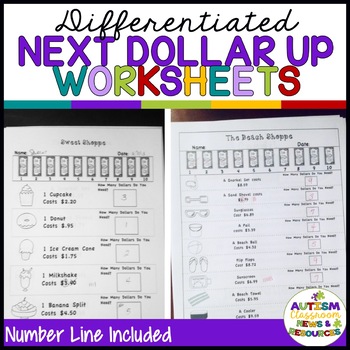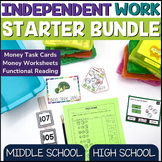Next Dollar Up Worksheets: Distance Learning Compatible
- PDF
- Google Apps™

What educators are saying
Also included in
- Everything you need to teach a variety of money skills, next dollar up, and coin counting skills with task cards and worksheets. These are perfect for special education classrooms. The pictures and items are all real-life items like groceries and restaurant foods so they are age-appropriate acrossPrice $13.20Original Price $16.50Save $3.30
- This set of next dollar up materials are perfect for teaching middle and high school students in special education how to use the dollar up method of making purchases. The next dollar up process involves teaching them to round the cents up to the next dollar. It helps students who are not able to maPrice $8.40Original Price $10.50Save $2.10
- This money-saving bundle combines 13 life-skills products (and a bonus coin sorting activity) and everything you need to get an independent work system set up in your middle or high school life skills classroom. Independent work is great for students who need practice completing a series of tasks wiPrice $44.00Original Price $57.00Save $13.00
Description
If you are looking for remote learning tools for life skills students, and you are teaching the next dollar up strategy, these worksheets are perfect. Recently added Google Slides version to the printable version. These 10 worksheets are a great way to get work product of student's performance in distance learning programs. And they can be completed online.
**Download the preview for 2 free worksheets!**
FEATURES:
- Printable in PDF format
- Accessible in Google Slides to share with students and complete online
- Choose specific pages in the slides to send home
- Worksheets are differentiated
- Dollar number line on each worksheet for counting
- Answer keys included
WHO IS IT FOR?
- Middle and high school students in special education
- Students learning next dollar up strategies
- Later elementary students working on functional curricula
WHAT'S INCLUDED?
- 10 black and white differentiated worksheets
- 3 worksheets with amounts to $5
- 7 worksheets with amounts to $10.
- Link to Google Slides for online learning
These worksheets are designed so that the students use the Next Dollar Up strategy to determine how many dollar bills are needed to buy a product. Using this strategy, you look at a price (say $1.50) and you give one more dollar than the number of dollars in the price (you give $2). So, if you want to buy something that has a price for 4.50, you give $5 and get back the change.
For more money resources in my store see
Next Dollar Up Task Cards: Money Skills [Special Education]
How Many Dollars? Task Cards: Money [Next Dollar] Skills [Special Education]
*****************************************************************************
This product is copyrighted to Christine Reeve for use in one classroom or one caseload. They may not be copied for additional classes without purchasing extra licenses.








